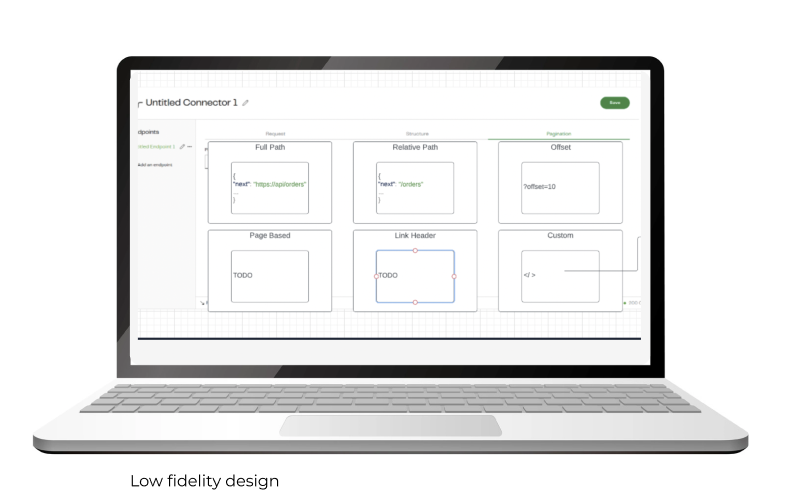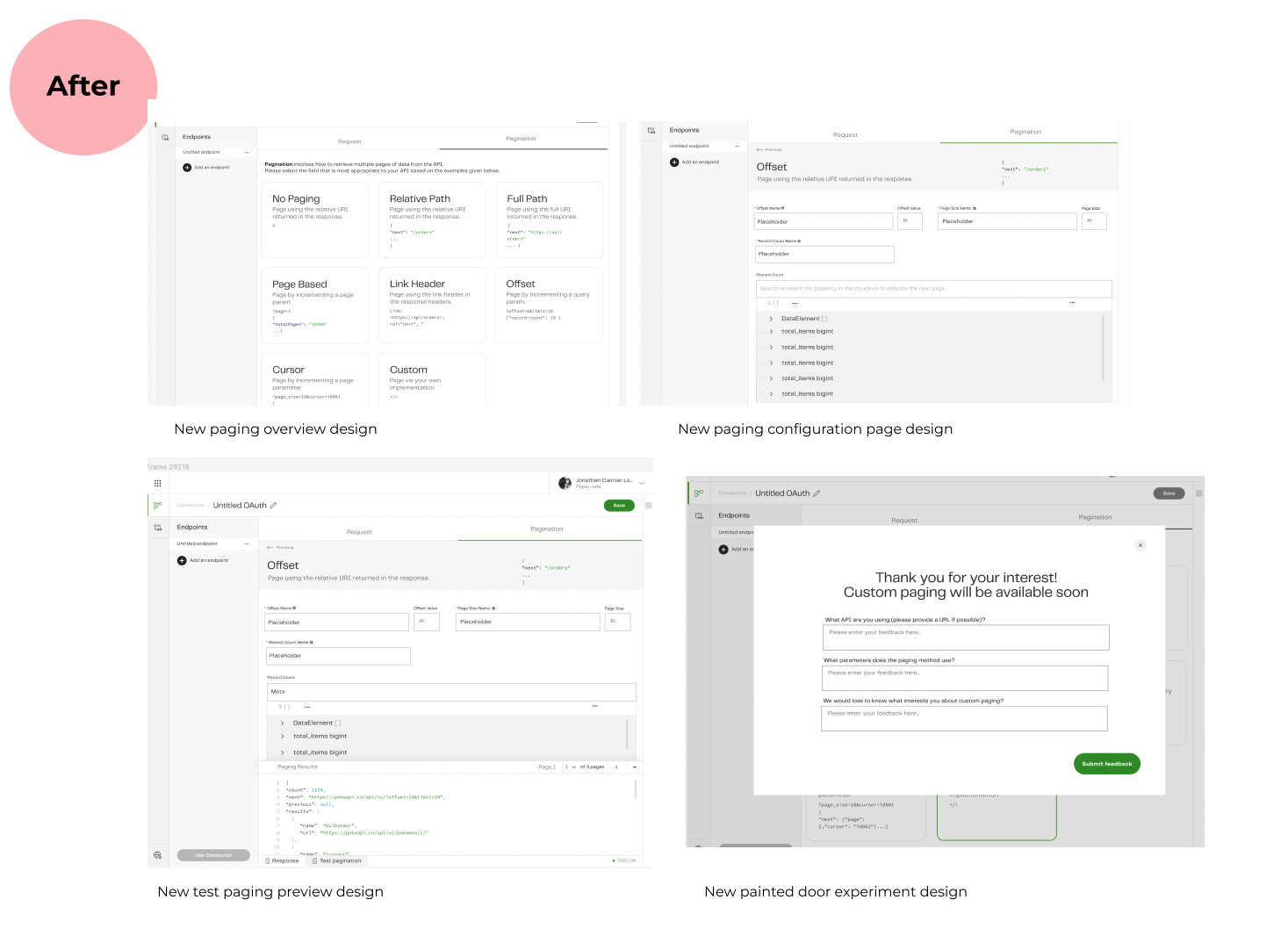Explore my portfolio
Custom connector paging strategy
Overview
About Project
- Custom connector: A no-code connector builder for APIs, used to create a connector profile for data extraction.
- Main Personas: ETL Developers or Data Engineers at Matillion who want to connect to an unsupported data source.
- Pagination/ Paging: Refers to the method of retrieving multiple pages of data from the API.
My Role
- Product Designer: Responsible for redesigning the pagination strategy for custom connector.
- Collaboration: Worked closely with Product Owners (POs), Product Managers (PMs), and engineers throughout the redesign process.
Problem
- User feedback: Valuable feedback from users highlighted the need to redesign the paging strategy in the custom connector.
- Lack of explanation: Users struggled due to the absence of clear explanations and information about the functions in the drop-down menu.
- Unfamiliar terminology: The terminology used was unfamiliar and not user-friendly, posing difficulties in understanding and configuring pagination.
- Inconsistent form fields: Some form fields lacked consistency and informative language, adding to the user’s confusion.

Design Process
User Research
- Analysing user feedback: Addressing user concerns by analysing feedback and identifying pain points.
- Thorough research: Conducting thorough research on paging approaches in competitor tools.
- Exploring solutions from competitors: Researching and studying solutions provided by competitors to gain insights and inspiration.
Ideation
- Collaboration with engineers: Working closely with engineers to understand the technical aspects involved in addressing user concerns.
- Incorporating visual representation: Recognising the importance of using visual representations, such as code snippets from the API, to enhance user comprehension.
- Allowing upfront comparison: Providing users with the ability to compare different strategies upfront before making their selection.
- Reducing clicks: Prioritising reducing the number of clicks to improve usability, following the principles of Nielsen Norman
Prototyping and Testing
- Low/high fidelity designs: Developing design prototypes at various levels of fidelity, allowing for feedback and iterations.
Iteration
- Iterations, feedback, and refinements: Engaging in multiple iterations, gathering feedback, and refining the design with input from engineers and the design team.
- Design readiness: Creating designs that are prepared to gather feedback and undergo iterative improvements.
- Iterative design process: Engaging in a continuous cycle of feedback and refinement based on the received input.
- Incorporating stakeholder feedback: Gathering feedback from stakeholders, such as PMs, PO’s, developers and design team, to inform design iterations.
- Enhancing design quality: Utilising feedback and iterations to enhance the overall quality and effectiveness of the designs.

Outcomes
Final Designs
- Clear display of eight tiles: The solution showcases eight tiles upfront, allowing users to compare different paging strategies using code snippets and concise descriptions.
- Aid in understanding and selection: The prominent display helps users understand and choose the appropriate paging strategy for their needs.
- Configuration: Once a strategy is chosen, users can further configure their strategy as required.
- Preview feature: Users can preview two to three pages based on their chosen strategy to ensure alignment with the API and test their configurations.
- Painted door experiment: A painted door experiment was introduced specifically for custom paging, aiming to gauge user interest and gather insights on their expectations.
- Gathering valuable user feedback: The experiment helps gather valuable feedback to refine the solution and improve it based on user preferences and needs.
- Thorough testing and refinement: The solution will undergo extensive testing among users upon release to better understand its effectiveness and make necessary refinements based on their feedback.
Impact and Results
User-Centric Redesign: Addressed valuable user feedback, resulting in a redesigned custom connector paging strategy that prioritises user needs and comprehension.
Enhanced User Understanding: Clear explanations and concise descriptions in the final designs alleviate user struggles, ensuring better understanding of functions and terminology.
Increased Usability: Reduced clicks and prioritizsed usability in the design process, aligning with Nielsen Norman principles, to create a more efficient and user-friendly experience.
Collaborative Design Process: Collaboration with Product Owners, Product Managers, and engineers throughout the design process ensured a holistic and well-informed approach.
Visual Representation Impact: Recognition of the importance of visual representations, such as code snippets, contributed to improved user comprehension and interaction.
Upfront Comparison Feature: Introduction of an upfront comparison feature allows users to compare different paging strategies, aiding in quick and informed decision-making.
Configurability: Users can now configure their chosen strategy, enhancing flexibility and customisation according to their specific requirements.
Preview Functionality: The preview feature enables users to test configurations with a preview of two to three pages, ensuring alignment with the API and validating their configurations.
Experimental Innovation: The introduction of the Painted Door Experiment for custom paging gauges user interest and gathers insights, contributing to ongoing refinement based on user preferences and needs.
Thorough Testing and Continuous Improvement: The solution undergoes extensive testing among users upon release, allowing for a continuous cycle of feedback and refinement to enhance its effectiveness.
- Language Consistency: Ensured consistent language usage by thoroughly understanding the meaning of each term before its application in the design.
- Iterative Design Excellence: Engaged in an iterative design process, incorporating stakeholder feedback and refining designs to enhance overall quality and effectiveness.
Challenges and Learnings
- Technical complexity: Overcame the challenge of understanding the technical aspects of paging by collaborating closely with an engineer and gaining in-depth knowledge of different paging strategies.
- Low/high fidelity designs: Developing design prototypes at various levels of fidelity, allowing for feedback and iterations.
- Varied paging strategies: Faced the challenge of accommodating diverse paging strategies, requiring careful consideration to maintain a consistent format.
- Addressing contrasting feedback: Managed the challenge of receiving contrasting feedback and leveraged design principles to develop solutions that best cater to user needs.





